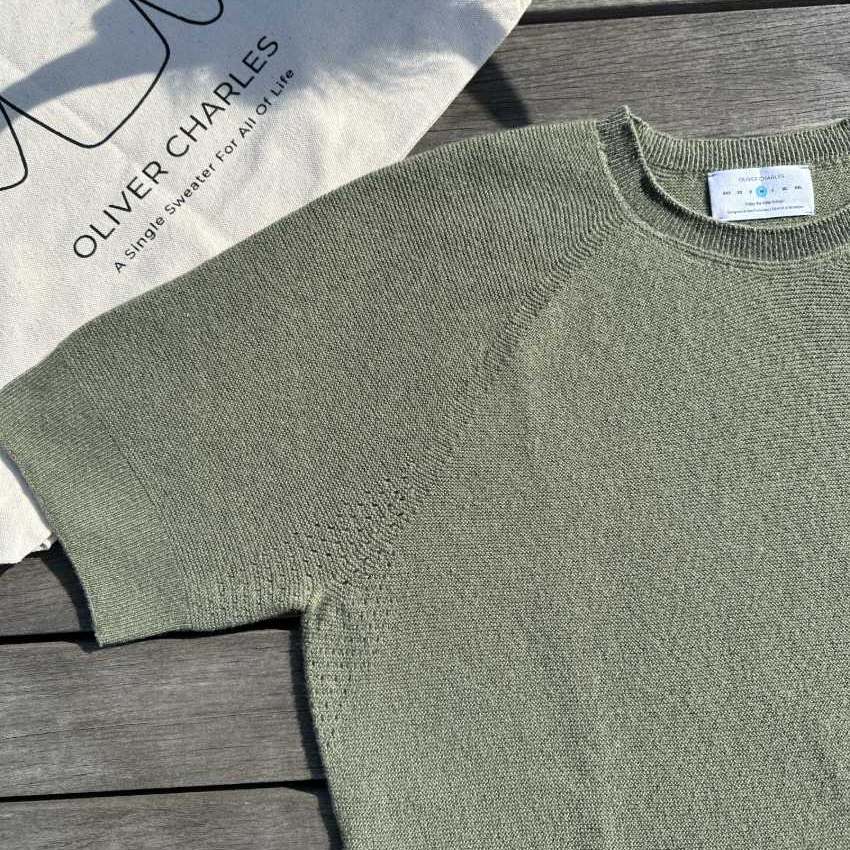3D-Knitting Is Worth It
3D-knitting is more sustainable, durable, and comfortable than other knitwear.
March 17, 2022
By Oliver Charles
Why Oliver Charles 3D-Knits Sweaters
Introducing a 4-part blog series about 3D-knitting.
While 3D-knitting remains more expensive than cut-and-sew and other forms of high volume manufacturing, we strongly believe it’s worth it.
- Guide To 3D-Knitting
- Why 3D-Knitting Is Worth It
- On-Demand = No Inventory Waste
- 3D-Knitting Has Unlimited Potential
----------
We couldn’t believe our luck the first time we set our eyes on a WHOLEGARMENT® machine - the very same machine that was contracted to knit our crew neck sweaters.
It was love at first sight. Our meet-and-greet with the sci-fi machine came about 2 weeks before our launch as a company.
Slater, one of our co-founders, found himself in Brooklyn, New York visiting our amazing manufacturing partner, Tailored Industry.
When Slater and Jack (the other co-founder) spoke on the phone after Slater’s tour of the production space, Jack remembered thinking...
“Slater was like a kid who found a shiny nickel. His excitement about what he saw was contagious as he described the 3D-knitting machine “print” our beautiful, lightweight crew neck sweater without a single seam.
He said, “Jack, it’s incredible! There’s no fabric wasted in the whole facility, the quality of the sweater seemed elevated, and it’ll surprise you how much lighter it is without the seam weight.”
I’ll never forget that moment of validation as these futuristic machines lived up to their reputation as the biggest innovation in the knitwear industry.”
Months after our launch, we’re still amazed by 3D-knitting technology, its potential, and, of course, the sweaters it “prints”.

What Is 3D-Knitting?
3D-knitting happens on the world’s most advanced computerized knitting machines.
We use Shima Seiki's WHOLEGARMENT® knitting machine for our production.
Each 3D-knitting machine is packed with thin, precise knitting needles that move to a complex beat, and like magic, produce durable, beautiful, lightweight, shaped knitwear at the end.
3D-Knitting Works Like This
Besides being seamless, 3D-knitting is a digital, standardized, and automated technology.
ll 3D-knitting starts with a digital three dimensional model of the item being produced - if you’re familiar with CAD (Computer Aided Design), it’s similar...
If you’re not familiar with 3D design, here’s a 1,000 ft look at how it works: skilled programmers use software to edit each individual stitch of the proposed knitwear, taking control over the texture, weight, direction, and pattern of the design.
Because there are only a few 3D-knitting machine manufacturers, digital modeling is standardized.
Without overcomplicating, designs can be transferred, downloaded, and knit on any 3D-knitting machine anywhere in the world.
After uploading the design and connecting the yarn, the 3D-knitting machine automatically creates a seamless, sustainable garment.
3D-Knitting Has Big Benefits
Today, clothing is largely produced quickly, cheaply, and hazardously. The focus on low-cost labor and high-quantity output has resulted in the mass production of fast fashion products that wear quickly and go out of style even faster.
3D-knitting solves this problem...
Not only is 3D-knitwear more sustainable than cut-and-sew garments, but it also creates more durable, versatile, lighter weight designs than cut-and-sew, 2D-knitting, and most circular knits.
3D-Knitting Is More Durable?
One of the main benefits of 3D-knitting is seamlessness. As 1 whole garment, produced as 1 continuous knit, there are few, if any, points where a seam unravels, snags, or rips.
Unlike 3D-knitting, both the cutting and the sewing process is prone to error; the most common are:
- Inconsistent cuts due to shifting fabric layers or blade velocity.
- Raw edges aren’t properly hemmed and unravel.
- Imprecise sewing causes pinching and/or seam separation.

3D-knitting Is Sustainable Vs. Fast Fashion
3D-knitting requires less raw material, produces less waste, and opens the door to an inventory-less future.
3D-knitting plays an important sustainability role because 35% (36 billion lbs**) of material in the global supply chain ends up as waste.
**That’s 50x as heavy as The Empire State Building.
If you’re wondering how we got here, consider the main drivers of waste: waste from cutting shapes out of fabric and waste from excess inventory.
#PROAllAccess: Fashion and Waste: An Uneasy Relationship
— Common Objective (@joinourco) January 30, 2020
Waste occurs throughout a garment’s life cycle, culminating in 57% of discarded clothes going to landfill each year. Better waste management offers huge cost savings and environmental benefits.https://t.co/rG38RYa4Ib
3D-Knitting Is The Future Of Knitwear
We’ve explored why 3D-knitting is a more sustainable, durable, and versatile alternative to other forms of knitwear production.
We also mentioned the inventory-less potential of 3D-knitting. Now let’s focus on two big additional innovations of 3D-knitting: personalized fit and “smart” applications.
It’s no secret that fit and sizing is confusing when shopping.
One company's medium could be another's large.
We wrote a blog about this topic about a month ago to investigate why.
Besides what’s mentioned in the blog, 3D-knitting offers a practical solution to create bespoke sizes for our customers.
With the combination of 3D body scanning technology like Fit 3D, size calculators based on weight and height like Wair, and 3D-knitting, personalized fit is possible today...
But that’s just the beginning. 3D-knitting also is capable of knitting conducive yarn, allowing for finished garments to be “smart”.
By knitting sensors into conductive patches, clothes can change temperature, identify moments of stress, and even improve balance.
We explore “smart” applications in depth in the second blog in this series.

Why Go Seamless?
When you wear a 3D-knit garment like our crew neck sweater, you’ll notice it feels light and shapes to the natural contours of your body.
The drape of the soft khullu and merino sweater will only be enhanced by our choice of links-links knit, which improves elasticity and range of motion.
3D-knitting creates more durable, versatile, sustainable, innovative knitwear.
- Without seams, 3D-knitting produces superior durability.
- The finesse of WHOLEGARMENT® machines adjusts every stitch for the ideal style and fit.
- At 99% efficiency, 3D-knitting is far more sustainable than cut-and-sew.
- 3D-knitting offers a path to personalized fit and “smart” applications.
While 3D-knitting remains more expensive than cut-and-sew and other forms of high volume manufacturing, we strongly believe it’s worth it.
If you believe that every good wardrobe starts with owning less and owning better, consider buying yourself an OLIVER CHARLES sweater.
Shop NowSustainable Sweaters For Self-Care
How investing in a sustainable wardrobe benefits our mental health.
Read more7 Day Challenge: Yak Wool Is Perfect For Winter And Spring
Testing the Oliver Charles All Season Boat Neck in classic Wyoming winter activities.
Read moreSeasonal Minimalist Wardrobe Is Out
All you need is one Oliver Charles sweater for all seasons.
Read moreThis Yak Wool Sweater Elevated My Wedding Weekend Wardrobe
How I stayed comfortable and stylish in a sweater during my wedding festivities.
Read more



